What Is The Largest Animal In The Atlantic Ocean
We love macro life, simply the body of water's biggest animals are awfully charismatic as well. Hither are our five favorite big animals that y'all might come across in the ocean.
Blue whale
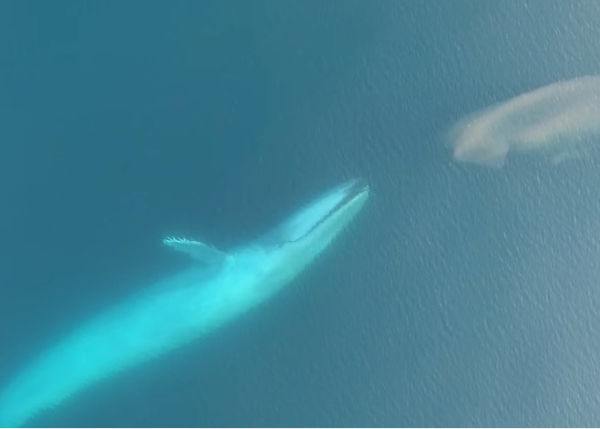 The blue whale is simply the biggest creature that has e'er lived on the planet. With a maximum length of around 100 feet (30 1000) and a weight close to 200 tons, a blue whale'southward size is comparable to a Boeing 737 aircraft. Can you imagine finding yourself in the water next to a plane-sized animal?
The blue whale is simply the biggest creature that has e'er lived on the planet. With a maximum length of around 100 feet (30 1000) and a weight close to 200 tons, a blue whale'southward size is comparable to a Boeing 737 aircraft. Can you imagine finding yourself in the water next to a plane-sized animal?
Funnily enough, these gigantic creatures feed on some of the ocean's smallest animals, krill, which they filter through the baleen they have in their mouth. On a expert day, an adult blue whale can consume up to 4 tons of krill.
At that place are v known subspecies of blue whale, which you tin discover in the North Pacific and Atlantic Oceans, the Antarctic ocean, North Indian Ocean, besides as areas effectually Indonesia, Australia, and New Zealand.
Some of the world's other biggest whale species include the sperm whale and the fin whale.
Whale shark
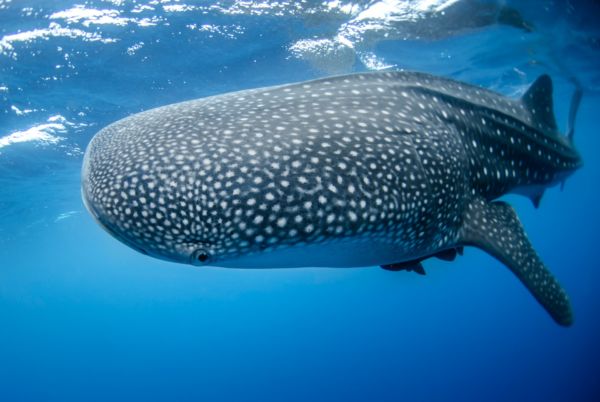
Despite its name, the whale shark belongs exclusively to the shark species, and it's the largest known shark at that. Averaging over 59 feet (18 one thousand), it is the largest non-mammalian vertebrate. Like blue whales, whale sharks are also filter feeders and live on a diet of plankton and pocket-size fishes.
Whale sharks enjoy tropical and warm, temperate waters. They are mainly pelagic, but seasonal aggregations occur when the sharks congregate to feed. On these occasions, divers and snorkelers may encounter hundreds of whale sharks gathered in the same place for a collective feeding frenzy. Popular areas for encounters include the Philippines, Thailand, Mexico, Mozambique, and Western Australia.
Orca
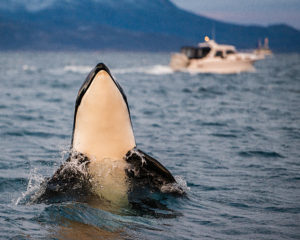
Also known as killer whales, orcas are toothed whales belonging to the oceanic dolphin family. These instantly recognizable animals are 1 of the ocean's biggest predators, along with the smashing white shark. They can reach up to 26 feet (eight chiliad) long and counterbalance vi tons. On top of the food chain, they take no known predators in the ocean. They feed on other animals such equally seals, dolphins, whales, and more.
They are nowadays in all the globe's oceans in various environments. Highly social and intelligent, they live usually in pods of up to a dozen individuals that remain together for most of their lives.
Mola mola
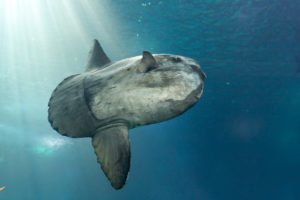
Weird and wonderful sums up the mola mola, also called the sunfish, perfectly. With a weight that can top a ton, this is the biggest bony fish species in the earth, and arguably one of the weirdest looking. Scientists also recall that they have the largest growth percentage in the animal kingdom: a mola mola larvae is only virtually 2 mm large, but within months it grows millions of times to accomplish its adult size, with a fin-to-fin length that can be over 8 anxiety (2.v g).
Mola molas usually bask deep, colder waters, merely they can hang out close to the surface at certain times of year or in areas of the Atlantic or Pacific Oceans, or even in the Mediterranean Sea. Some of the best places to spot them reliably are Bali and the Galapagos.
Just a few countries consider their mankind a delicacy and, despite their huge size, they practise have several natural predators, such as orcas and sharks. They feed mainly on modest fish, crustaceans and squids.
Giant manta ray
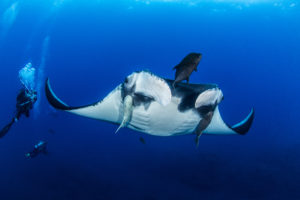
Granted, the giant oceanic manta ray might not exist every bit big as some whales, but information technology is the biggest ray of all. The biggest individuals can attain a disk size of 23 feet (7 one thousand) across, which can make you experience like a spaceship is flight above your head if yous ever have the chance to dive with one.
Like their cousins, reef mantas, they feed mainly on plankton, which they scoop upwardly with their cephalic fins, located airtight to their mouth. The common traits between the two species are many, but oceanic manta rays are usually bigger and have distinctive markings on their backs and bellies.
Lucky defined tin see them in tropical waters all effectually the world, in places such as Japan, Mexico, Egypt, Peru, South Africa, Indonesia, and New Zealand. A pop spot to dive with them is Isla de la Plata in Ecuador.
Source: https://scubadiverlife.com/five-of-the-oceans-biggest-animals/
Posted by: arnoldtherstion1975.blogspot.com

0 Response to "What Is The Largest Animal In The Atlantic Ocean"
Post a Comment